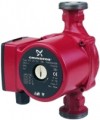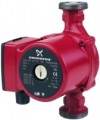Max. flow
The maximum flow of a pump is the amount of liquid it can pump in a certain amount of time.
Features of choosing the optimal performance option depend primarily on the purpose of the pump (see above). For example, for DHW recirculation models, the pump performance should not exceed the performance of the water heater. If the water heater is capable of delivering 10 litres per minute to the DHW circuit, then the maximum pump performance will be 10*60=600 L/h. The basic formula for calculating the performance of a heating system takes into account the power of the heater and the temperature difference at the inlet and outlet, and for the cold water system — the number of points of water intake. More detailed information about the calculations for each application can be found in special sources, and it is better to entrust the calculations themselves to professionals.
Max. head
The head can be described as the maximum height to which a pump can lift liquid through a vertical pipe without bending or branching. This parameter is directly related to the pressure that the pump produces: 10 m of head approximately corresponds to a pressure of 1 bar (do not confuse this parameter with operating pressure — see more about it below).
The head is one of the key specs for most circulation pumps. Traditionally, it is calculated based on the difference in height between the location of the pump and the highest point of the system; however, this principle is relevant only for units that
boost the pressure of cold water(see "Suitable for"). Circulation pumps for heating and DHW work with closed circuits, and the optimal pressure depends on the total hydraulic resistance of the system. Detailed calculation formulas for the first and second cases can be found in special sources.
Max. power consumption
The electrical power consumed by the pump during normal operation and maximum performance.
This indicator directly depends on performance — after all, for pumping large volumes of water, an appropriate amount of energy is needed. And the power depends on two main parameters — electricity consumption and the load on the power grid, which determines the connection rules. For example, pumps with a power of more than 5 kW cannot be connected to ordinary household sockets; more detailed rules can be found in special sources.
Mains voltage
Operating voltage for which the pump is designed.
— 230 V. Standard voltage of household networks. Most of these pumps can be powered from a regular outlet, which makes them very convenient to connect. At the same time, this option is not well suited for creating high-performance units — already with a power consumption of more than 5 kW, certain tricks in connection will be required, and in general, 230 V provide less power than 400 V. Therefore, the such power supply is typical mainly for models elementary and intermediate levels.
— 400 V. This option implies power supply from three-phase networks with a voltage of 400 V. Such networks are rarely found in everyday life, but they are widely used in the professional field, including at industrial facilities — they are convenient for powering high-power equipment. Therefore, three-phase power is usually provided in professional high-performance pumps.
Port-to-port length
The installation length is the distance between the inlet and outlet of the pump, in other words, the length of the segment occupied by the pump in the circuit. This parameter allows you to estimate the amount of space required for the unit, and determine the length of the pipe section that needs to be cut.

